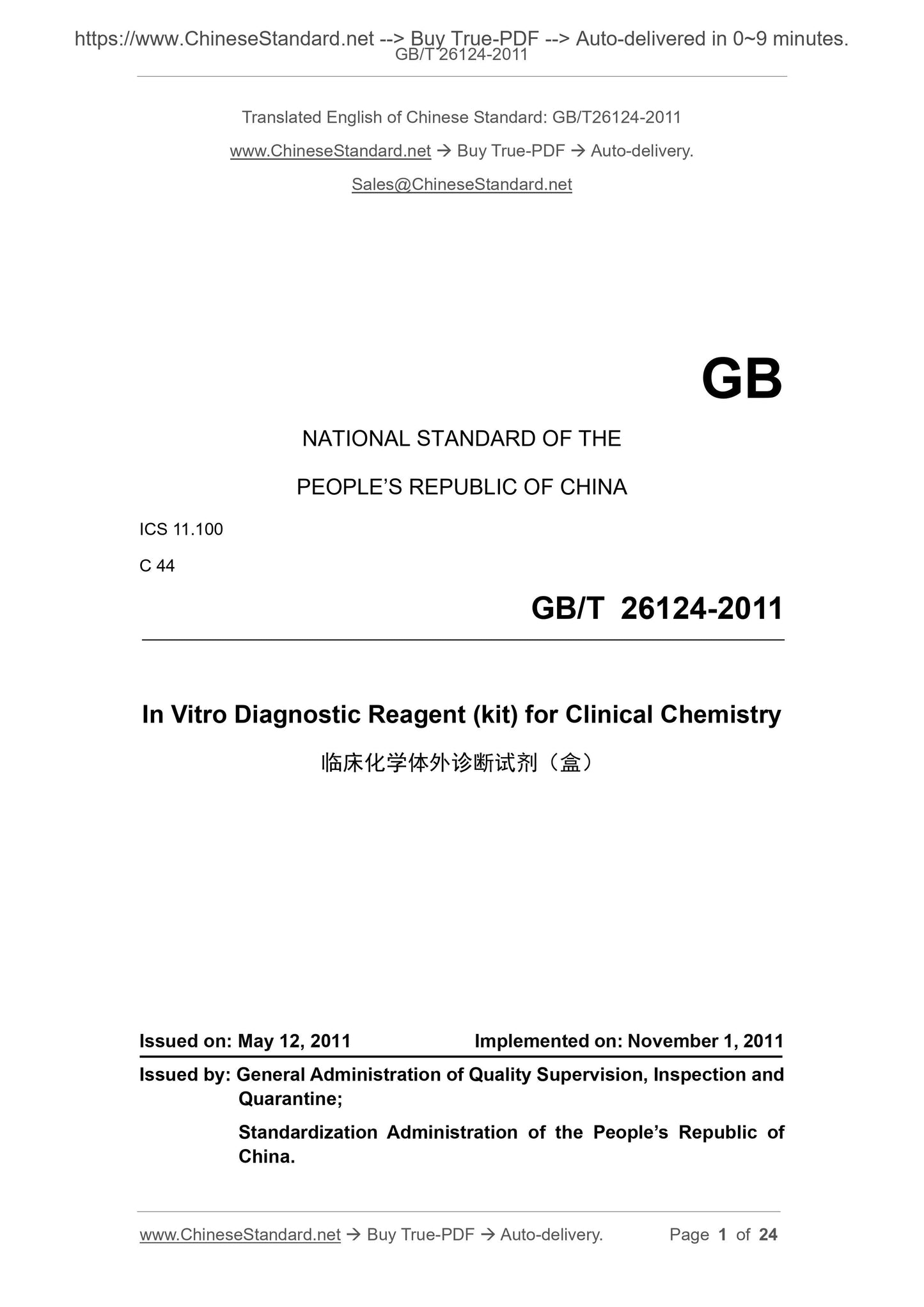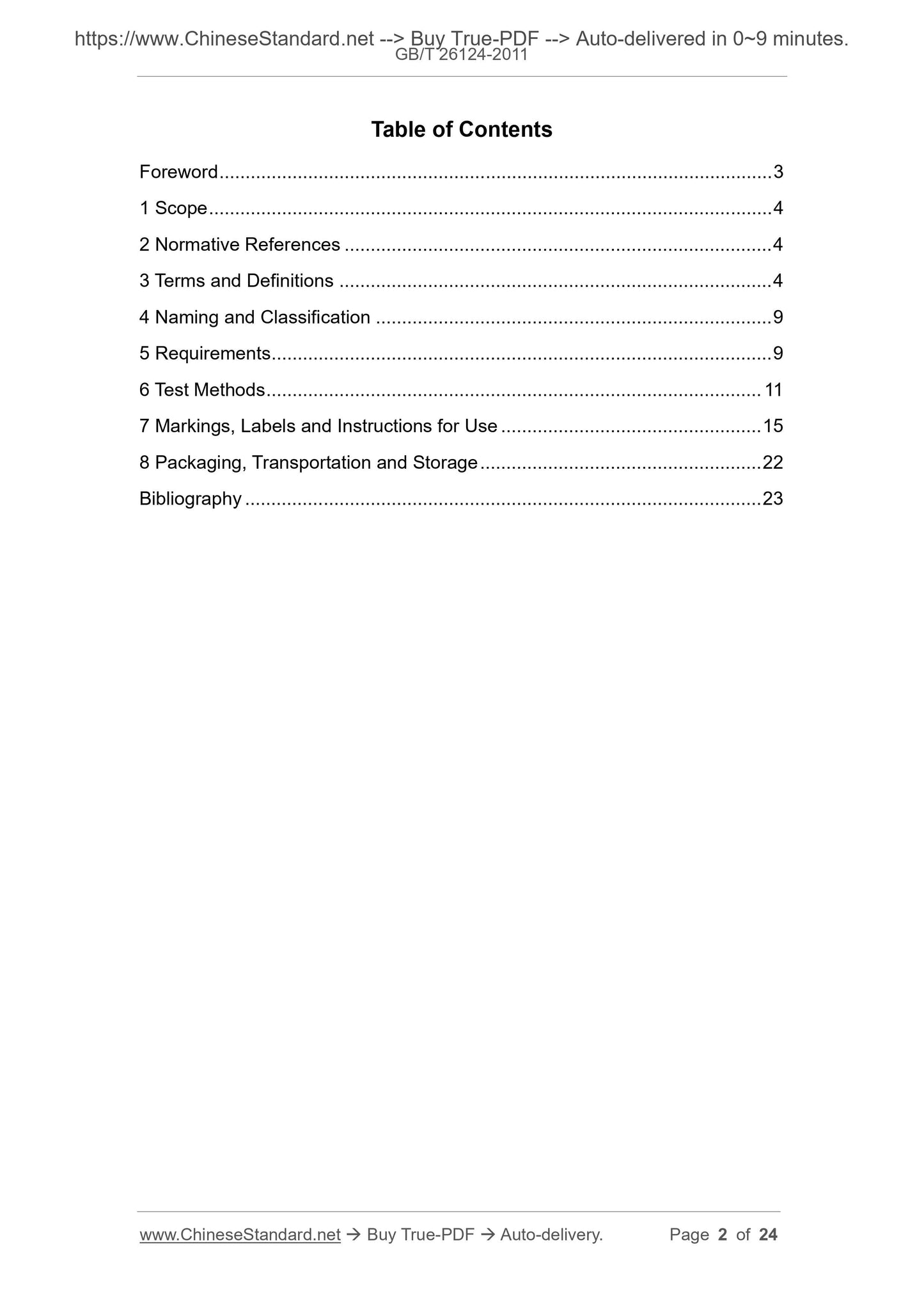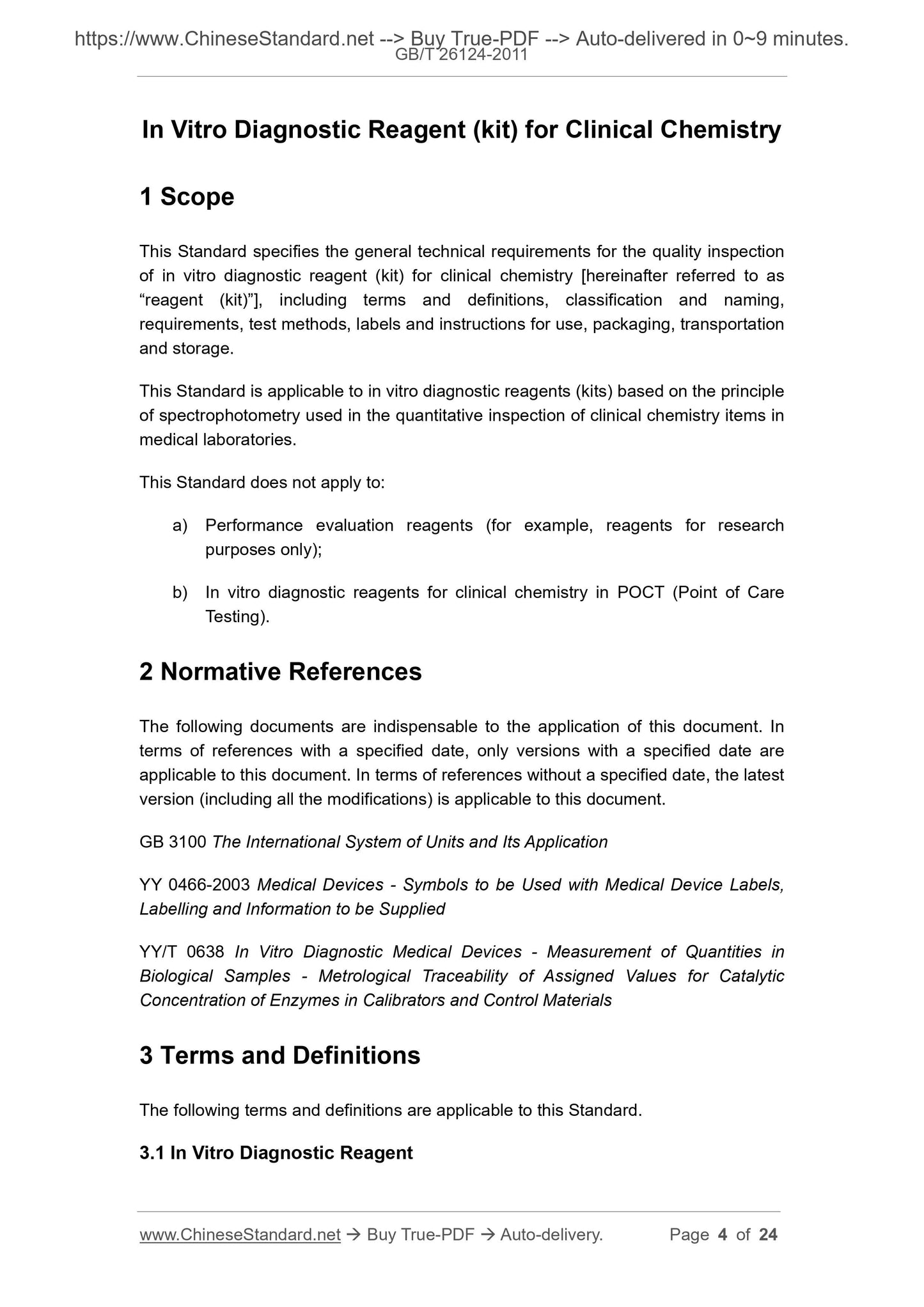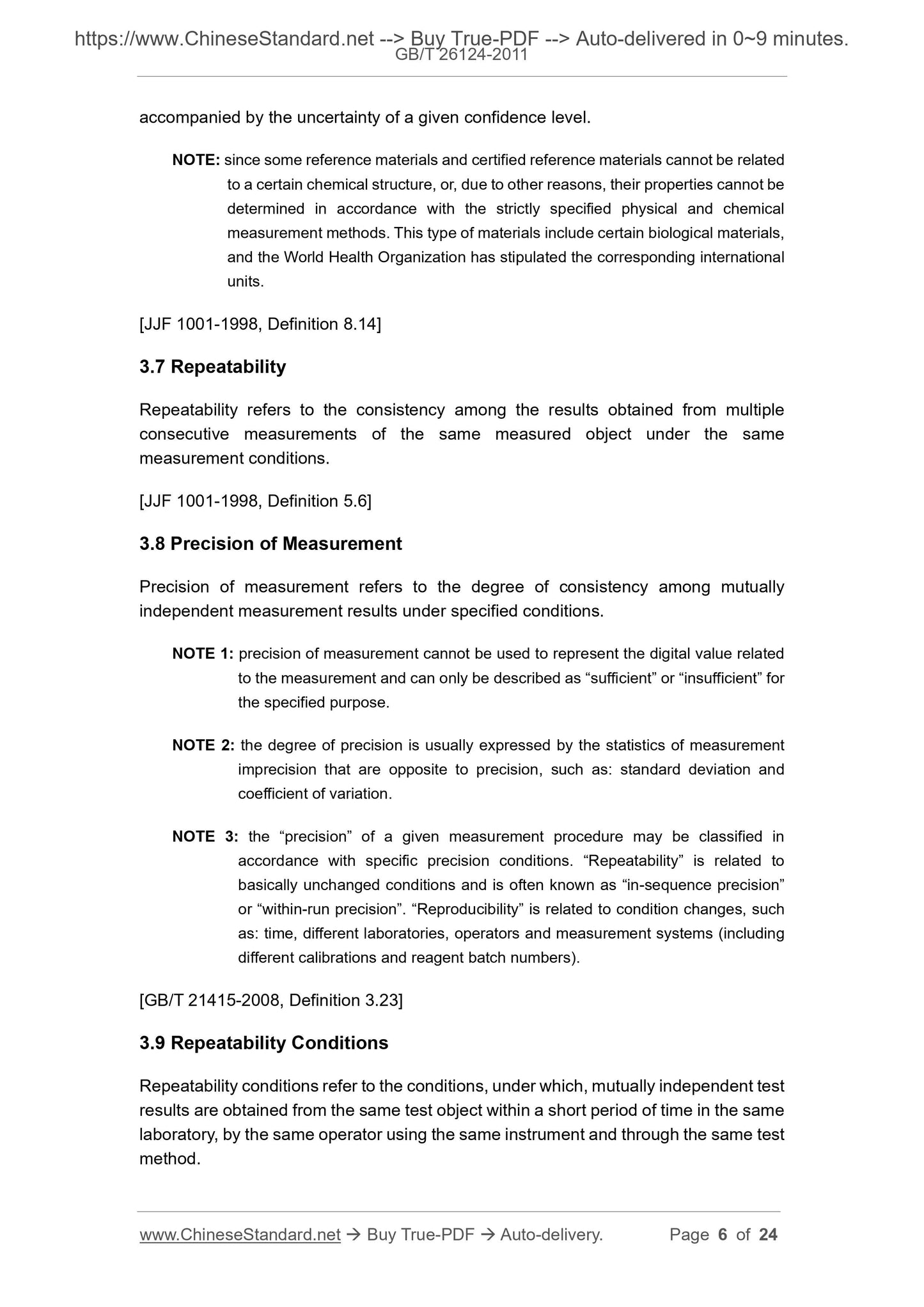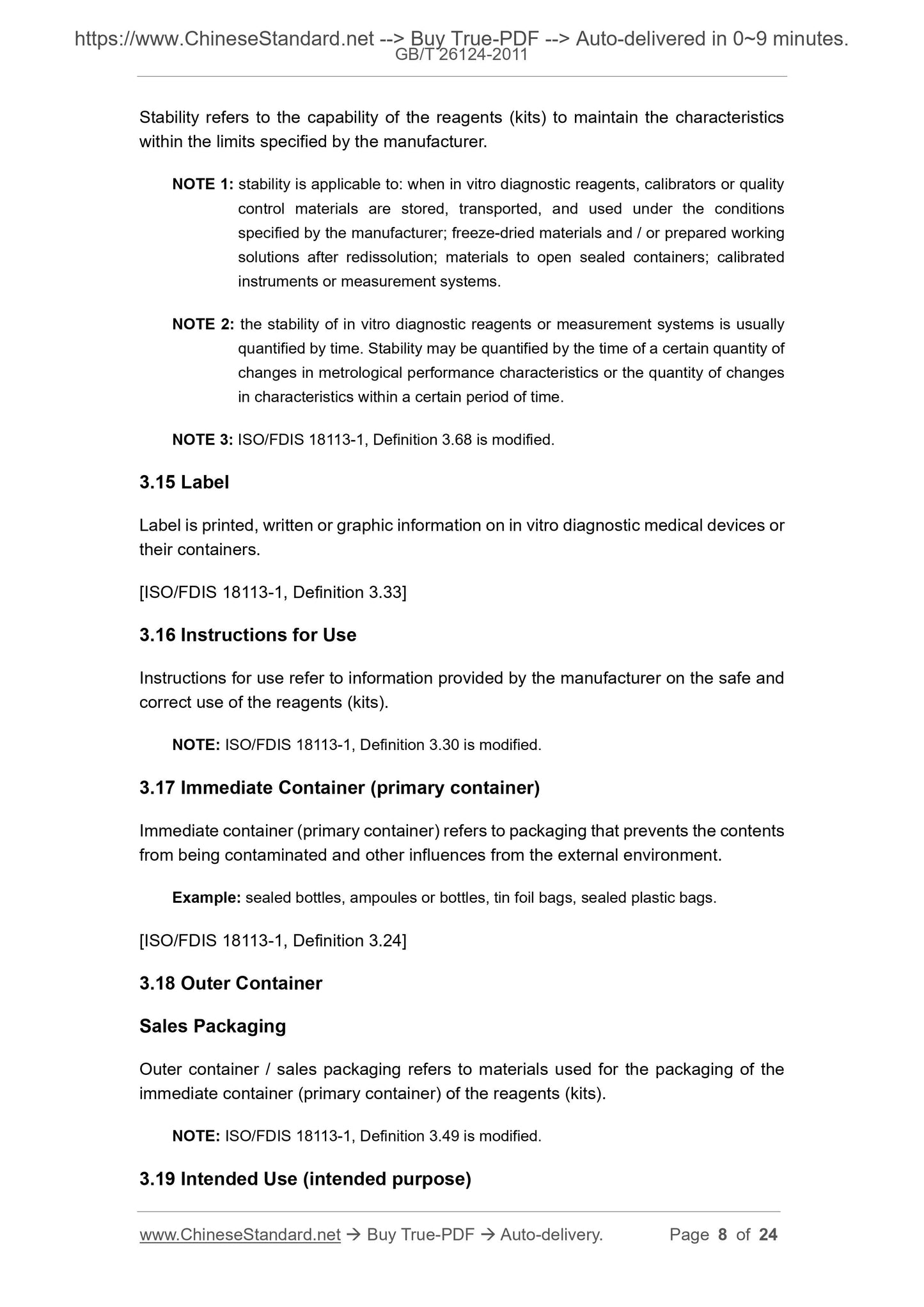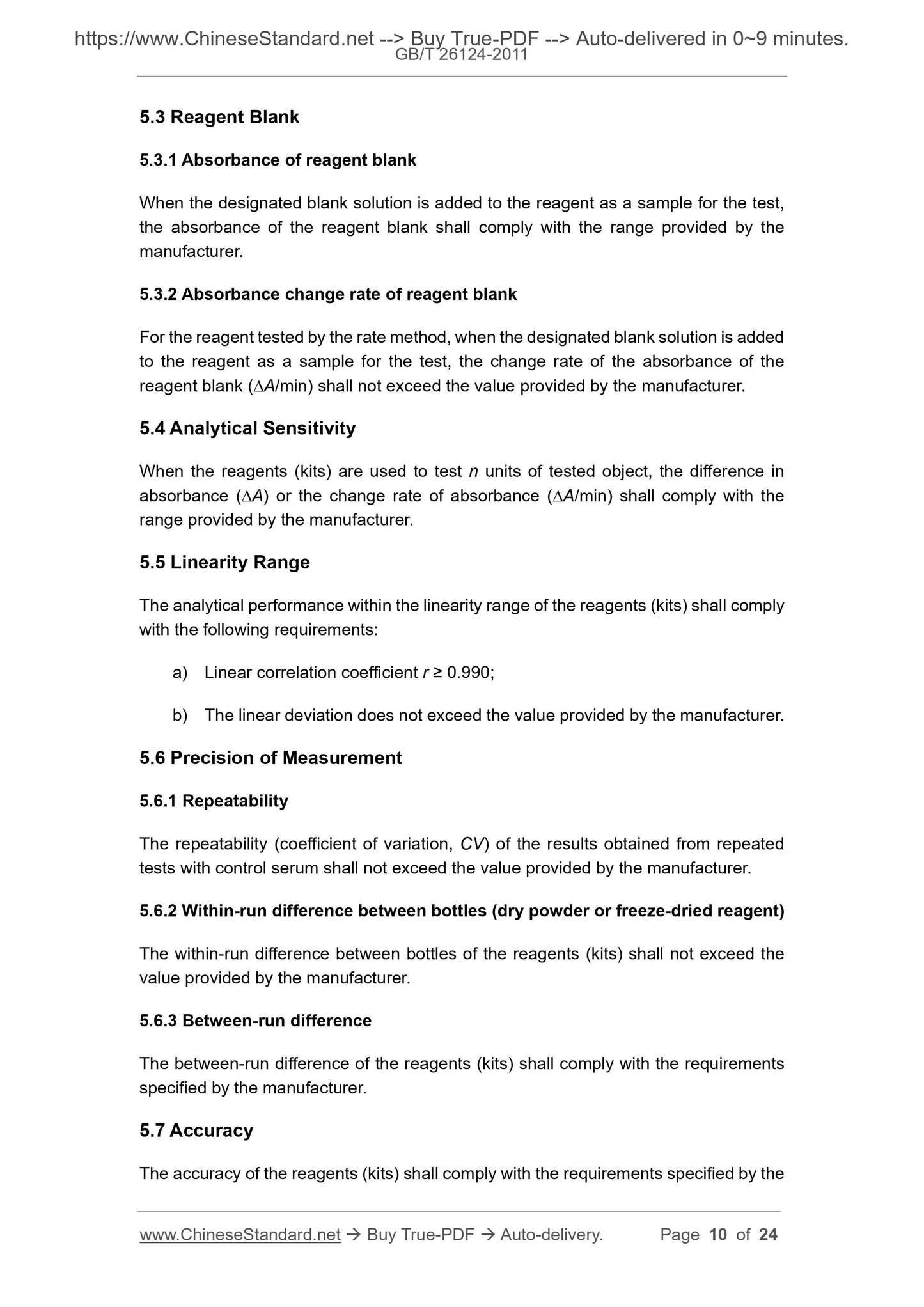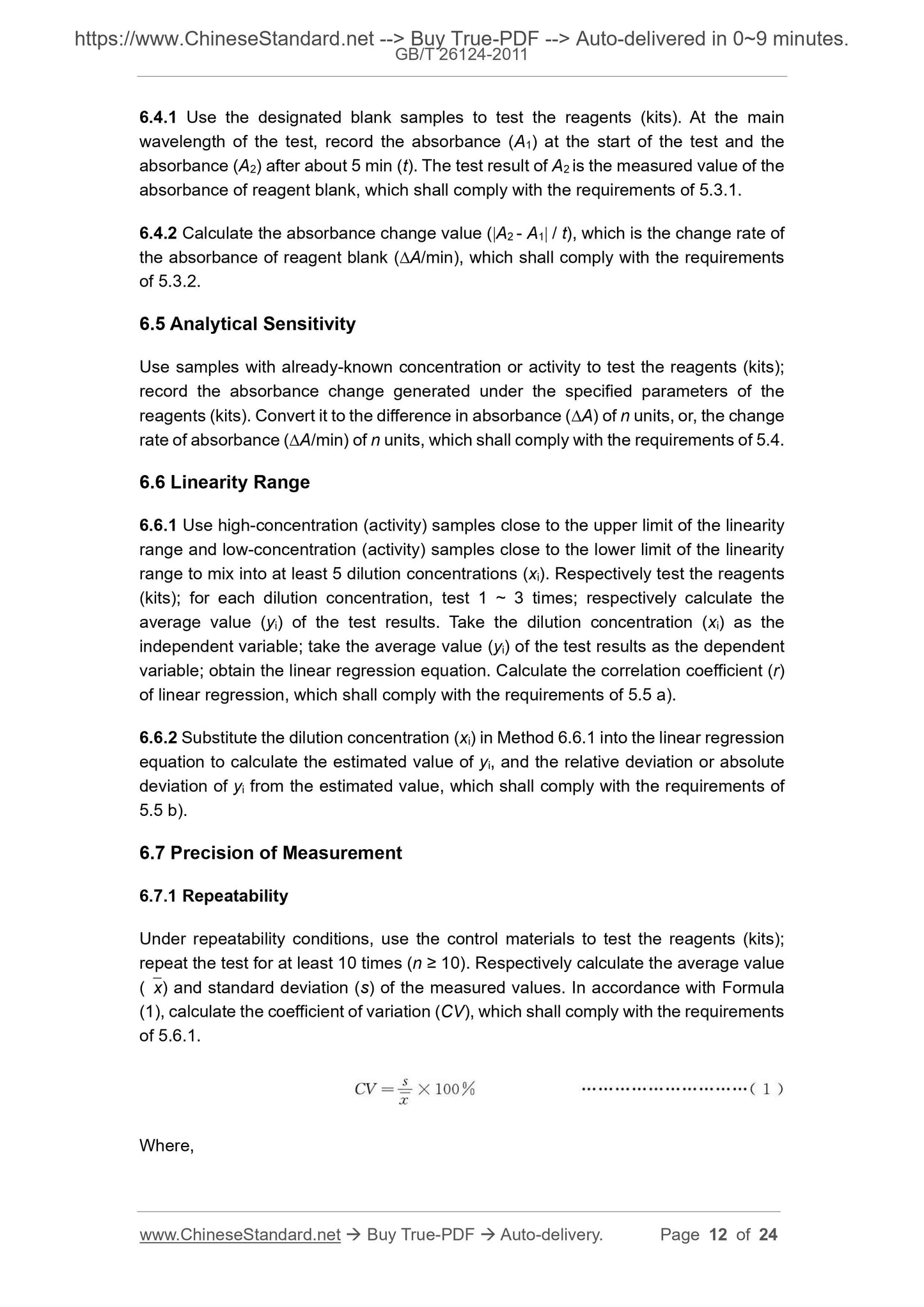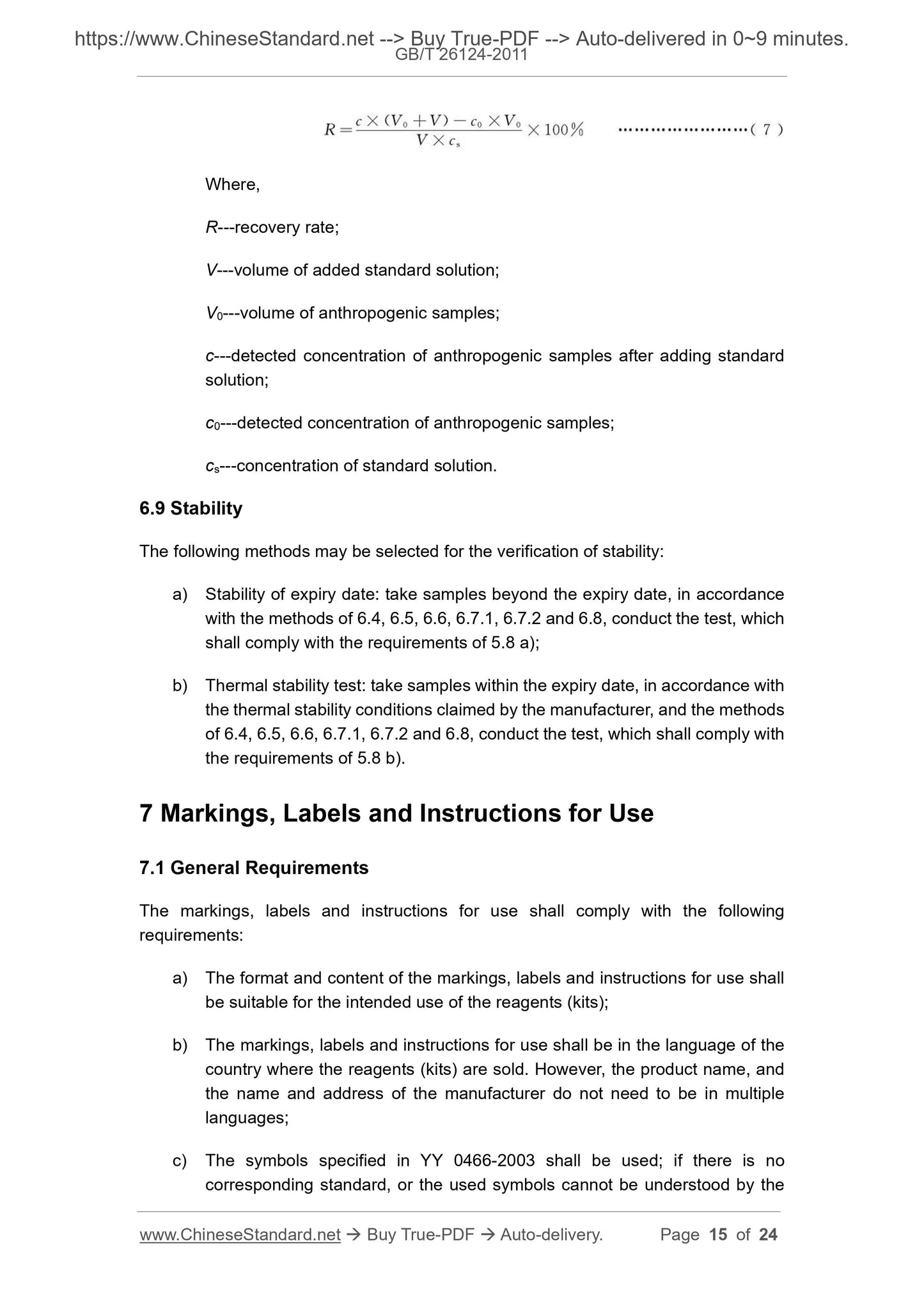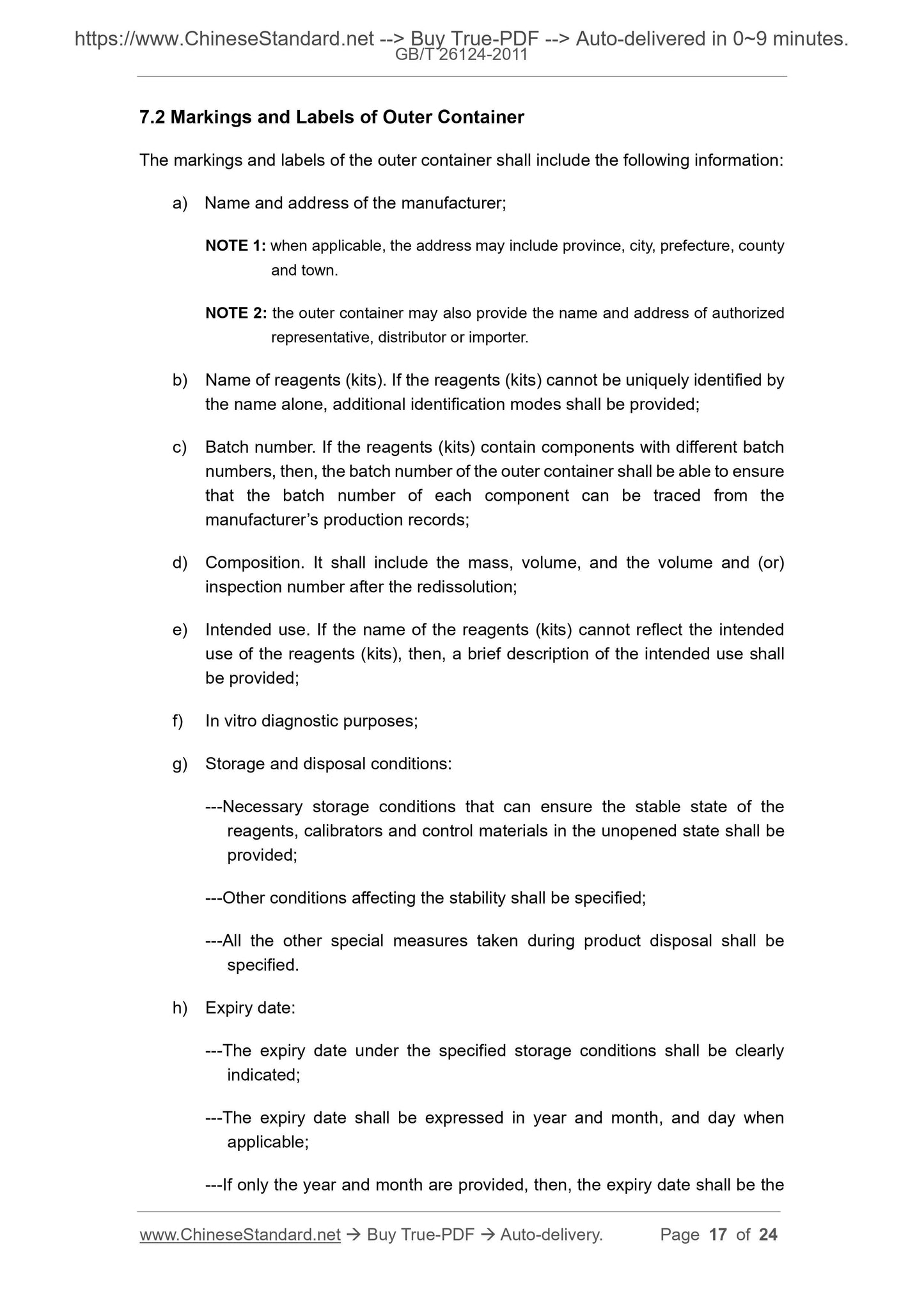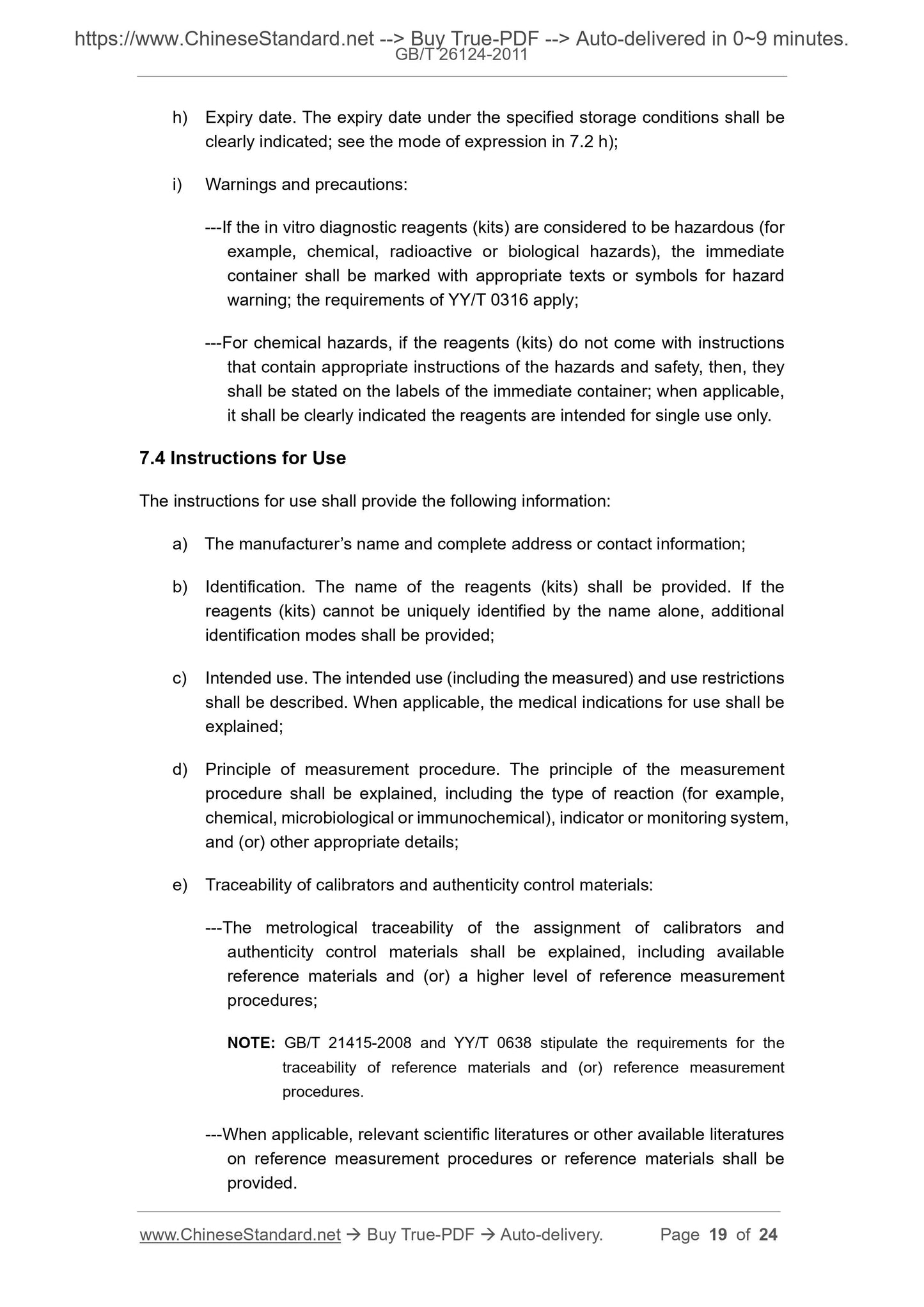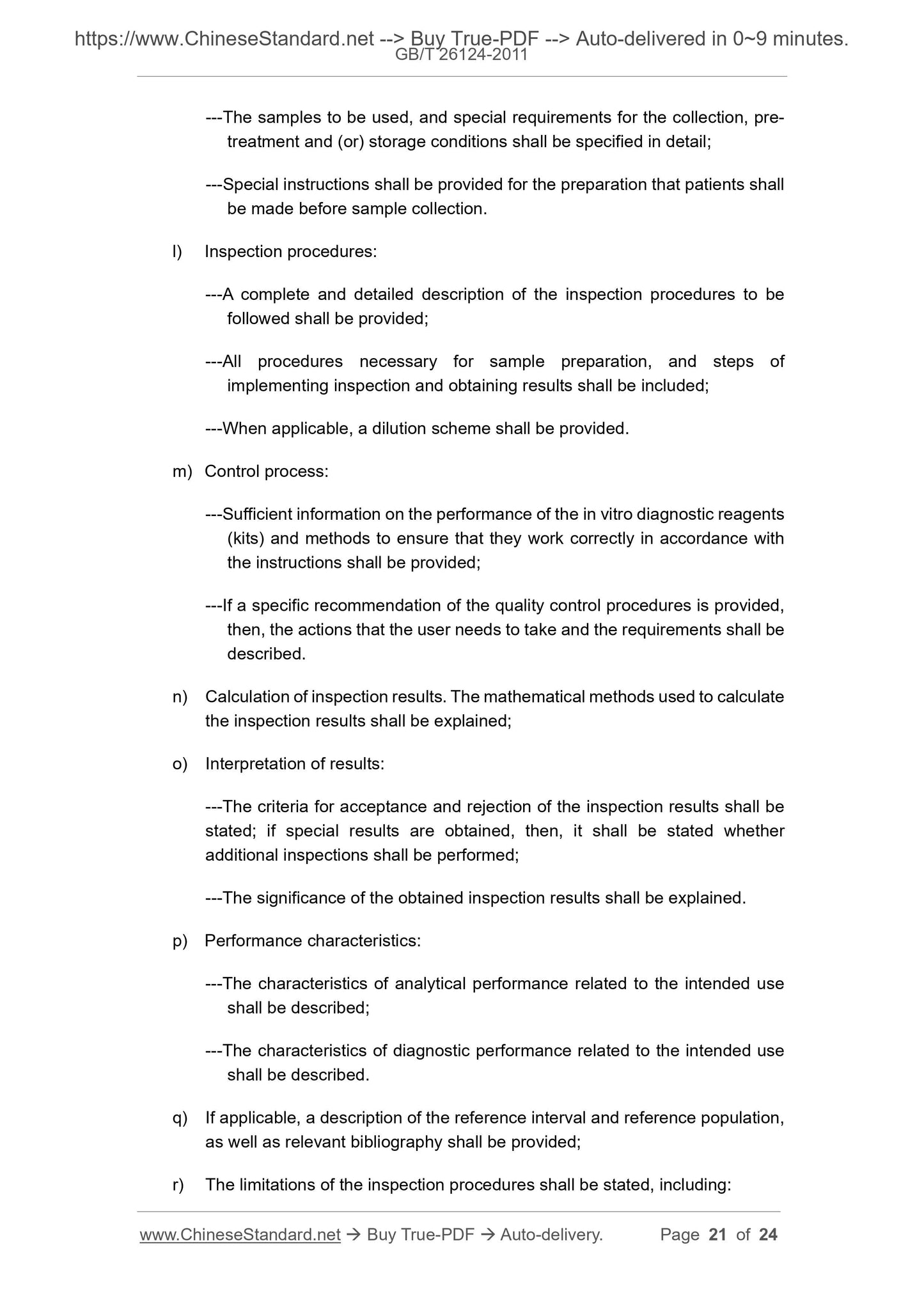PayPal, credit cards. Download editable-PDF and invoice in 1 second!
GB/T 26124-2011 English PDF (GBT26124-2011)
GB/T 26124-2011 English PDF (GBT26124-2011)
Precio habitual
$290.00 USD
Precio habitual
Precio de oferta
$290.00 USD
Precio unitario
/
por
Los gastos de envío se calculan en la pantalla de pago.
No se pudo cargar la disponibilidad de retiro
Delivery: 3 seconds. Download true-PDF + Invoice.
Get QUOTATION in 1-minute: Click GB/T 26124-2011
Historical versions: GB/T 26124-2011
Preview True-PDF (Reload/Scroll if blank)
GB/T 26124-2011: In vitro diagnostic reagent (kit) for clinical chemistry
GB/T 26124-2011
GB
NATIONAL STANDARD OF THE
PEOPLE’S REPUBLIC OF CHINA
ICS 11.100
C 44
In Vitro Diagnostic Reagent (kit) for Clinical Chemistry
ISSUED ON: MAY 12, 2011
IMPLEMENTED ON: NOVEMBER 1, 2011
Issued by: General Administration of Quality Supervision, Inspection and
Quarantine;
Standardization Administration of the People’s Republic of
China.
Table of Contents
Foreword ... 3
1 Scope ... 4
2 Normative References ... 4
3 Terms and Definitions ... 4
4 Naming and Classification ... 9
5 Requirements ... 9
6 Test Methods ... 11
7 Markings, Labels and Instructions for Use ... 15
8 Packaging, Transportation and Storage ... 22
Bibliography ... 23
In Vitro Diagnostic Reagent (kit) for Clinical Chemistry
1 Scope
This Standard specifies the general technical requirements for the quality inspection
of in vitro diagnostic reagent (kit) for clinical chemistry [hereinafter referred to as
“reagent (kit)”], including terms and definitions, classification and naming,
requirements, test methods, labels and instructions for use, packaging, transportation
and storage.
This Standard is applicable to in vitro diagnostic reagents (kits) based on the principle
of spectrophotometry used in the quantitative inspection of clinical chemistry items in
medical laboratories.
This Standard does not apply to:
a) Performance evaluation reagents (for example, reagents for research
purposes only);
b) In vitro diagnostic reagents for clinical chemistry in POCT (Point of Care
Testing).
2 Normative References
The following documents are indispensable to the application of this document. In
terms of references with a specified date, only versions with a specified date are
applicable to this document. In terms of references without a specified date, the latest
version (including all the modifications) is applicable to this document.
GB 3100 The International System of Units and Its Application
YY 0466-2003 Medical Devices - Symbols to be Used with Medical Device Labels,
Labelling and Information to be Supplied
YY/T 0638 In Vitro Diagnostic Medical Devices - Measurement of Quantities in
Biological Samples - Metrological Traceability of Assigned Values for Catalytic
Concentration of Enzymes in Calibrators and Control Materials
3 Terms and Definitions
The following terms and definitions are applicable to this Standard.
3.1 In Vitro Diagnostic Reagent
accompanied by the uncertainty of a given confidence level.
NOTE: since some reference materials and certified reference materials cannot be related
to a certain chemical structure, or, due to other reasons, their properties cannot be
determined in accordance with the strictly specified physical and chemical
measurement methods. This type of materials include certain biological materials,
and the World Health Organization has stipulated the corresponding international
units.
[JJF 1001-1998, Definition 8.14]
3.7 Repeatability
Repeatability refers to the consistency among the results obtained from multiple
consecutive measurements of the same measured object under the same
measurement conditions.
[JJF 1001-1998, Definition 5.6]
3.8 Precision of Measurement
Precision of measurement refers to the degree of consistency among mutually
independent measurement results under specified conditions.
NOTE 1: precision of measurement cannot be used to represent the digital value related
to the measurement and can only be described as “sufficient” or “insufficient” for
the specified purpose.
NOTE 2: the degree of precision is usually expressed by the statistics of measurement
imprecision that are opposite to precision, such as: standard deviation and
coefficient of variation.
NOTE 3: the “precision” of a given measurement procedure may be classified in
accordance with specific precision conditions. “Repeatability” is related to
basically unchanged conditions and is often known as “in-sequence precision”
or “within-run precision”. “Reproducibility” is related to condition changes, such
as: time, different laboratories, operators and measurement systems (including
different calibrations and reagent batch numbers).
[GB/T 21415-2008, Definition 3.23]
3.9 Repeatability Conditions
Repeatability conditions refer to the conditions, under which, mutually independent test
results are obtained from the same test object within a short period of time in the same
laboratory, by the same operator using the same instrument and through the same test
method.
Stability refers to the capability of the reagents (kits) to maintain the characteristics
within the limits specified by the manufacturer.
NOTE 1: stability is applicable to: when in vitro diagnostic reagents, calibrators or quality
control materials are stored, transported, and used under the conditions
specified by the manufacturer; freeze-dried materials and / or prepared working
solutions after redissolution; materials to open sealed containers; calibrated
instruments or measurement systems.
NOTE 2: the stability of in vitro diagnostic reagents or measurement systems is usually
quantified by time. Stability may be quantified by the time of a certain quantity of
changes in metrological performance characteristics or the quantity of changes
in characteristics within a certain period of time.
NOTE 3: ISO/FDIS 18113-1, Definition 3.68 is modified.
3.15 Label
Label is printed, written or graphic information on in vitro diagnostic medical devices or
their containers.
[ISO/FDIS 18113-1, Definition 3.33]
3.16 Instructions for Use
Instructions for use refer to information provided by the manufacturer on the safe and
correct use of the reagents (kits).
NOTE: ISO/FDIS 18113-1, Definition 3.30 is modified.
3.17 Immediate Container (primary container)
Immediate container (primary container) refers to packaging that prevents the contents
from being contaminated and other influences from the external environment.
Example: sealed bottles, ampoules or bottles, tin foil bags, sealed plastic bags.
[ISO/FDIS 18113-1, Definition 3.24]
3.18 Outer Container
Sales Packaging
Outer container / sales packaging refers to materials used for the packaging of the
immediate container (primary container) of the reagents (kits).
NOTE: ISO/FDIS 18113-1, Definition 3.49 is modified.
3.19 Intended Use (intended purpose)
5.3 Reagent Blank
5.3.1 Absorbance of reagent blank
When the designated blank solution is added to the reagent as a sample for the test,
the absorbance of the reagent blank shall comply with the range provided by the
manufacturer.
5.3.2 Absorbance change rate of reagent blank
For the reagent tested by the rate method, when the designated blank solution is added
to the reagent as a sample for the test, the change rate of the absorbance of the
reagent blank (A/min) shall not exceed the value provided by the manufacturer.
5.4 Analytical Sensitivity
When the reagents (kits) are used to test n units of tested object, the difference in
absorbance (A) or the change rate of absorbance (A/min) shall comply with the
range provided by the manufacturer.
5.5 Linearity Range
The analytical performance within the linearity range of the reagents (kits) shall comply
with the following requirements:
a) Linear correlation coefficient r ≥ 0.990;
b) The linear deviation does not exceed the value provided by the manufacturer.
5.6 Precision of Measurement
5.6.1 Repeatabilit...
Get QUOTATION in 1-minute: Click GB/T 26124-2011
Historical versions: GB/T 26124-2011
Preview True-PDF (Reload/Scroll if blank)
GB/T 26124-2011: In vitro diagnostic reagent (kit) for clinical chemistry
GB/T 26124-2011
GB
NATIONAL STANDARD OF THE
PEOPLE’S REPUBLIC OF CHINA
ICS 11.100
C 44
In Vitro Diagnostic Reagent (kit) for Clinical Chemistry
ISSUED ON: MAY 12, 2011
IMPLEMENTED ON: NOVEMBER 1, 2011
Issued by: General Administration of Quality Supervision, Inspection and
Quarantine;
Standardization Administration of the People’s Republic of
China.
Table of Contents
Foreword ... 3
1 Scope ... 4
2 Normative References ... 4
3 Terms and Definitions ... 4
4 Naming and Classification ... 9
5 Requirements ... 9
6 Test Methods ... 11
7 Markings, Labels and Instructions for Use ... 15
8 Packaging, Transportation and Storage ... 22
Bibliography ... 23
In Vitro Diagnostic Reagent (kit) for Clinical Chemistry
1 Scope
This Standard specifies the general technical requirements for the quality inspection
of in vitro diagnostic reagent (kit) for clinical chemistry [hereinafter referred to as
“reagent (kit)”], including terms and definitions, classification and naming,
requirements, test methods, labels and instructions for use, packaging, transportation
and storage.
This Standard is applicable to in vitro diagnostic reagents (kits) based on the principle
of spectrophotometry used in the quantitative inspection of clinical chemistry items in
medical laboratories.
This Standard does not apply to:
a) Performance evaluation reagents (for example, reagents for research
purposes only);
b) In vitro diagnostic reagents for clinical chemistry in POCT (Point of Care
Testing).
2 Normative References
The following documents are indispensable to the application of this document. In
terms of references with a specified date, only versions with a specified date are
applicable to this document. In terms of references without a specified date, the latest
version (including all the modifications) is applicable to this document.
GB 3100 The International System of Units and Its Application
YY 0466-2003 Medical Devices - Symbols to be Used with Medical Device Labels,
Labelling and Information to be Supplied
YY/T 0638 In Vitro Diagnostic Medical Devices - Measurement of Quantities in
Biological Samples - Metrological Traceability of Assigned Values for Catalytic
Concentration of Enzymes in Calibrators and Control Materials
3 Terms and Definitions
The following terms and definitions are applicable to this Standard.
3.1 In Vitro Diagnostic Reagent
accompanied by the uncertainty of a given confidence level.
NOTE: since some reference materials and certified reference materials cannot be related
to a certain chemical structure, or, due to other reasons, their properties cannot be
determined in accordance with the strictly specified physical and chemical
measurement methods. This type of materials include certain biological materials,
and the World Health Organization has stipulated the corresponding international
units.
[JJF 1001-1998, Definition 8.14]
3.7 Repeatability
Repeatability refers to the consistency among the results obtained from multiple
consecutive measurements of the same measured object under the same
measurement conditions.
[JJF 1001-1998, Definition 5.6]
3.8 Precision of Measurement
Precision of measurement refers to the degree of consistency among mutually
independent measurement results under specified conditions.
NOTE 1: precision of measurement cannot be used to represent the digital value related
to the measurement and can only be described as “sufficient” or “insufficient” for
the specified purpose.
NOTE 2: the degree of precision is usually expressed by the statistics of measurement
imprecision that are opposite to precision, such as: standard deviation and
coefficient of variation.
NOTE 3: the “precision” of a given measurement procedure may be classified in
accordance with specific precision conditions. “Repeatability” is related to
basically unchanged conditions and is often known as “in-sequence precision”
or “within-run precision”. “Reproducibility” is related to condition changes, such
as: time, different laboratories, operators and measurement systems (including
different calibrations and reagent batch numbers).
[GB/T 21415-2008, Definition 3.23]
3.9 Repeatability Conditions
Repeatability conditions refer to the conditions, under which, mutually independent test
results are obtained from the same test object within a short period of time in the same
laboratory, by the same operator using the same instrument and through the same test
method.
Stability refers to the capability of the reagents (kits) to maintain the characteristics
within the limits specified by the manufacturer.
NOTE 1: stability is applicable to: when in vitro diagnostic reagents, calibrators or quality
control materials are stored, transported, and used under the conditions
specified by the manufacturer; freeze-dried materials and / or prepared working
solutions after redissolution; materials to open sealed containers; calibrated
instruments or measurement systems.
NOTE 2: the stability of in vitro diagnostic reagents or measurement systems is usually
quantified by time. Stability may be quantified by the time of a certain quantity of
changes in metrological performance characteristics or the quantity of changes
in characteristics within a certain period of time.
NOTE 3: ISO/FDIS 18113-1, Definition 3.68 is modified.
3.15 Label
Label is printed, written or graphic information on in vitro diagnostic medical devices or
their containers.
[ISO/FDIS 18113-1, Definition 3.33]
3.16 Instructions for Use
Instructions for use refer to information provided by the manufacturer on the safe and
correct use of the reagents (kits).
NOTE: ISO/FDIS 18113-1, Definition 3.30 is modified.
3.17 Immediate Container (primary container)
Immediate container (primary container) refers to packaging that prevents the contents
from being contaminated and other influences from the external environment.
Example: sealed bottles, ampoules or bottles, tin foil bags, sealed plastic bags.
[ISO/FDIS 18113-1, Definition 3.24]
3.18 Outer Container
Sales Packaging
Outer container / sales packaging refers to materials used for the packaging of the
immediate container (primary container) of the reagents (kits).
NOTE: ISO/FDIS 18113-1, Definition 3.49 is modified.
3.19 Intended Use (intended purpose)
5.3 Reagent Blank
5.3.1 Absorbance of reagent blank
When the designated blank solution is added to the reagent as a sample for the test,
the absorbance of the reagent blank shall comply with the range provided by the
manufacturer.
5.3.2 Absorbance change rate of reagent blank
For the reagent tested by the rate method, when the designated blank solution is added
to the reagent as a sample for the test, the change rate of the absorbance of the
reagent blank (A/min) shall not exceed the value provided by the manufacturer.
5.4 Analytical Sensitivity
When the reagents (kits) are used to test n units of tested object, the difference in
absorbance (A) or the change rate of absorbance (A/min) shall comply with the
range provided by the manufacturer.
5.5 Linearity Range
The analytical performance within the linearity range of the reagents (kits) shall comply
with the following requirements:
a) Linear correlation coefficient r ≥ 0.990;
b) The linear deviation does not exceed the value provided by the manufacturer.
5.6 Precision of Measurement
5.6.1 Repeatabilit...
Share
